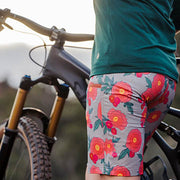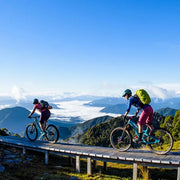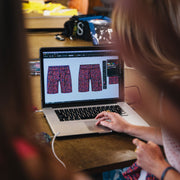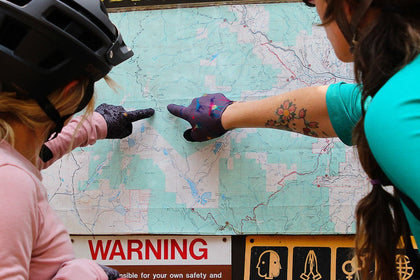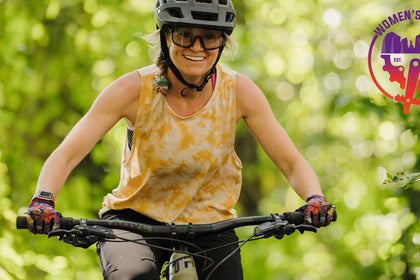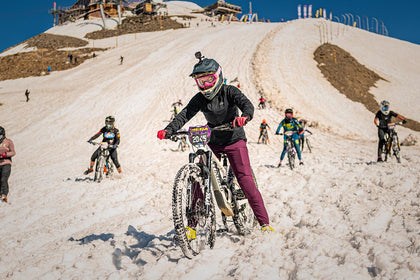Written by Abby Chan, MS, RDN, RYT
As a Registered Dietitian, working with athletes and disordered eating has been my passion and life’s mission for over six years. I have seen a lot in this short period of time. I have witnessed nutrition literally make or break an athlete… no joke. Underfeeding yourself on and off the bike will lead to poor recovery, decreased power, increased risk for stress fractures, gastrointestinal disorders, compromised hormone function, and a decline in mental health. Anecdotally, I have found that women have a harder time feeding themselves during sport, and statistically, up to 45% of female athletes struggle with a clinical eating disorder.
This is why the conversation about food and cycling matters.
The worst feeling in the world is when you’re having a blast of a day on your bike, and suddenly you start to feel yourself slowly losing your grip on reality. This, my friends, is what we call “bonking.” Bonking is a term that typically refers to the state of hypoglycemia and glycogen depletion, but can also be due to dehydration. Symptoms may include fatigue, lightheadedness, increased heart rate, irritability, the feeling of heavy muscles, anxiety, and decreased performance.
Let’s back up and cover some basic nutrition facts:
- Glucose (sugar) is your body’s preferred and most efficient source of energy. All carbohydrates are eventually broken down into glucose.
- Glycogen is a storage molecule made up of glucose and water. It is mainly stored in your liver and muscles.
- When exercising, your body will first use glucose circulating in your blood (“blood sugar”). When blood glucose runs low, enzymes are activated to mobilize glycogen to continue to fuel your brain, muscles, and body.
- If you run out of both blood glucose and glycogen, you will begin to “bonk.”
- Hydration is also critical: dehydration causes blood volume to drop and heart rate to increase, which can lead to gastrointestinal (GI) distress, nausea, and vomiting.
Key takeaways: We want to avoid glucose/glycogen depletion and dehydration, especially when riding.
So, how do we stay hydrated and fueled?
My mantra is “early and often.” Guzzling water and food is not your ticket out of Bonk Town if you’ve already arrived. Absorbing food and water takes longer when you are exercising, so plan on eating and drinking in small amounts and frequently. Drinking a low carbohydrate-electrolyte drink and eating more solid foods can help with GI distress and dehydration. Yes, you can use high carbohydrate drinks as a fueling strategy, but just be sure to test them out for tolerance before you head out for a race or a big ride.
Let’s break down the most important aspects of fueling your body before, during, and after your ride.
Before Your Ride:
Make sure that you eat a solid meal about two to three hours before you head out. This could look like a breakfast burrito, oatmeal with nuts and fruit, yogurt with granola and fruit, or a sandwich with a side of chips and fruit. You ideally want to have a balance of carbohydrates, protein, and fat. Eating two to three hours in advance will give you ample time to digest and give your body long sustained energy and nutrients to make it through your ride.
During Your Ride:
As long as you eat throughout the day (especially a meal 2-3 hours before your ride), you should not have to worry about bonking if you are heading out on a ride that is less than 60 minutes. You should be just fine with a bike bottle of water, perhaps with added electrolytes if you are in a hot and/or humid climate.
However, if you are planning on a ride longer than 60 minutes, then paying attention to your nutrition is essential. As we all know, rides can be unpredictable, which means I always recommend having more food onboard as opposed to less. If you get a flat tire, get injured, or have a climb that takes way longer than anticipated, having some extra fuel handy is a lifesaver. It is not extreme to say that failing to fuel yourself in the backcountry can lead to very dangerous situations.
During rides longer than 60 minutes, you should plan on eating something that is rich in carbohydrates after about 40-45 minutes. This can be at the top of a climb, at a re-grouping spot, or at an epic view. You may not be hungry at this point, but remember, “early and often” is the key. Eat before you are hungry and drink before you are thirsty. Also, make sure you are drinking water and some electrolytes as you’re pedaling.
After your first pit stop at the 40-45 minute mark, make sure that you continue taking a few bites of something every 20-40 minutes. Again, “early and often” is the key. Depending on your body size and ride intensity, aim for 40-60 grams per hour of carbohydrate-rich foods. This doesn’t have to be (and probably shouldn’t be) all at one time. When exercising, your body will tolerate food better in smaller amounts.
For long rides that are 3 hours or more, be sure to pack food with protein and fats in addition to carbohydrates. This will help to sustain you for the long haul. Foods that can work well are nuts, jerky, burrito, or a sandwich. Again, I recommend eating these in small bites over time rather than all at once, or by taking a leisurely stop for lunch if you have time.
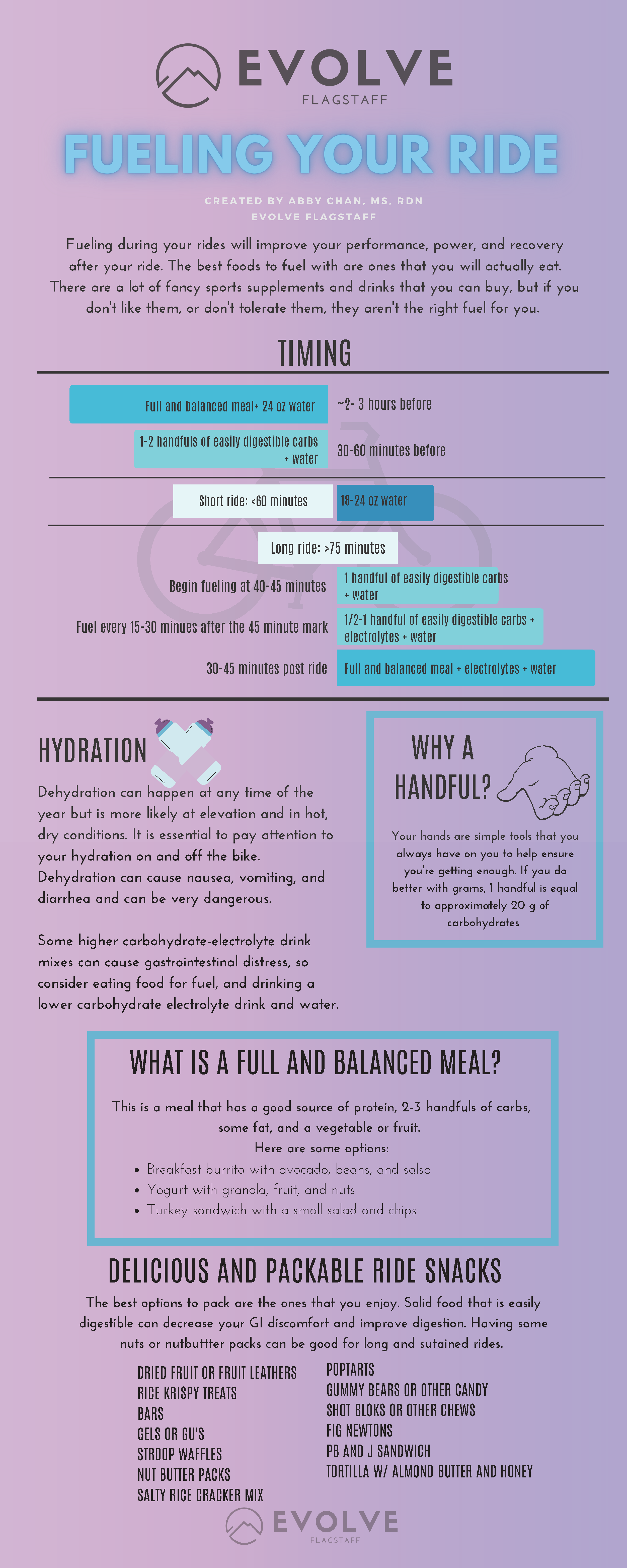
Some of my favorite riding snacks are Rice Krispie treats, fruit leathers, dried fruit, Hi-Chew gummies, and Pop Tarts. And don’t be afraid of eating “high sugar foods” when riding… what do you think Shot Bloks and energy gels are? “Energy gels” and “energy blocks” are typically just high sugar mixtures, perhaps with added electrolytes. They can work great if you like them and can afford them, but if not, you can feel free to find something else that fits your budget and your palette.
Finally, don’t be afraid to experiment and find what works for you! And, if you are not typically used to eating while riding, know that your body can take time to adjust, but should adapt to digest while on the move. If you continue to struggle with a nutrition strategy for your rides, I definitely recommend seeing a Registered Dietitian that works with endurance athletes.
After Your Ride:
After working hard, your body needs to recover from your ride. Aim to have a full and balanced meal within about 30-60 minutes of your ride. You may not be hungry, and that is because your body is still coming down after your ride. But, the first 30-60 minutes after exercise is when your body is primed to optimally absorb nutrients. Also, if you don’t eat soon, you will be a ravenous bear later. No one wants you to be #hangry.
Try to have a meal that you enjoy, and that contains a balance of carbohydrates for glycogen repletion, protein for muscle recovery, fats for energy and satiety, and some colors (fruits or vegetables) to replace nutrients.
So, to sum up:
- Your body needs nutrients for optimal performance
- Glucose and glycogen are key fuel sources for endurance activities
- Don’t be afraid of carbohydrates and sugar!!
- Eat and drink early and often when riding
- Eat and drink what you enjoy and what agrees with you
- Aim to eat a balanced meal before and after your ride
And of course, reach out to a Registered Dietitian for more support!
Shred on ✌🏽
*This article is not designed to be used for personalized nutrition guidelines and is not a replacement for working with a Registered Dietitian.*
